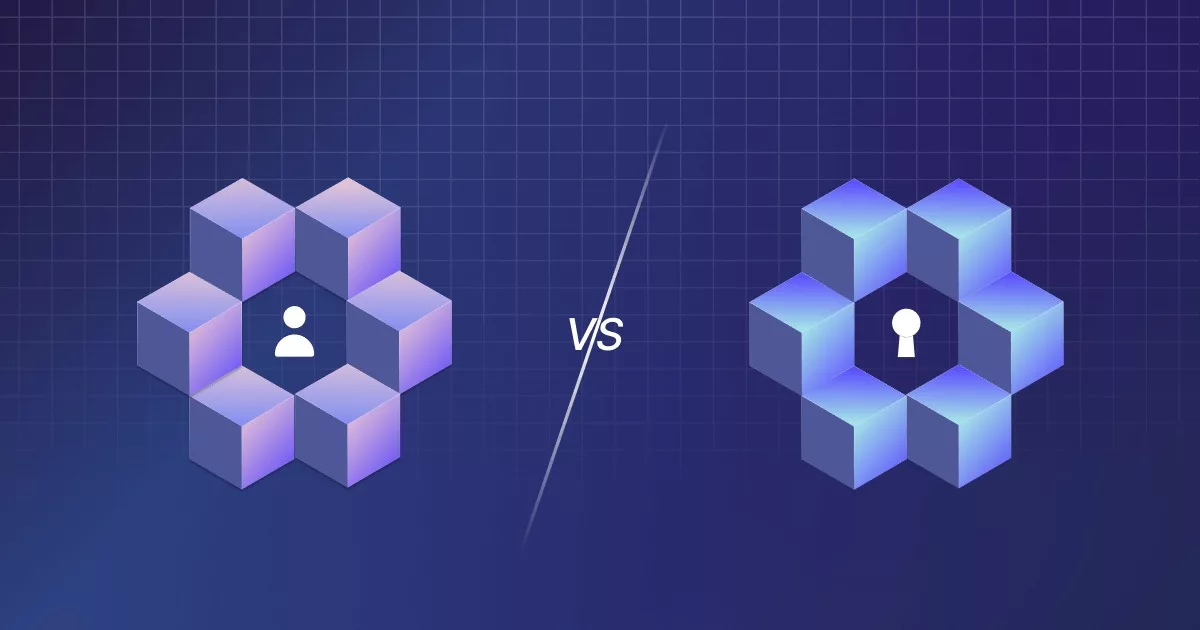
Blockchain has proved to be a valuable tool for businesses. It offers solutions to various problems like data security, transparency, etc. Well, it all started in 2008 when Bitcoin, the first decentralized cryptocurrency, launched. And Blockchain is the underlying technology behind Bitcoin. Initially, only ‘public blockchains’ existed where anyone could participate in the network. But with time, the potential of this technology became increasingly apparent. Thus organizations began to explore the possibility of ‘private blockchains’ for internal use. Public and private blockchains have unique characteristics that make them more suitable for specific use cases than others. Here we will understand their fundamental differences and provide insights into which one may fit your business.
Public Blockchain Explained
First, let’s define what a public blockchain is.
Simply put, it’s a distributed ledger that anyone can access and use without needing any permission. That means anyone can participate in the network, whether you’re an individual, a business, or a government.
Now, let’s talk about how public blockchains work.
Imagine a big notebook where everyone can write, and every page has a unique code. Every time someone writes a new entry, it gets added to the end of the book and brings its own unique code. From a blockchain perspective, each page is a ‘block,’ and the unique code is a ‘hash.’
Every block in the chain has a hash linked to the previous block’s hash. It creates a chain that you can’t alter without breaking it. If someone tries to change one block, it will change the hash of every block after it. It becomes instantly apparent that something has been tampered with.
Also, the data verification happens with the help of ‘Consensus Mechanisms.’
A consensus mechanism is a process by which the network participants agree on the validity of transactions. It ensures the network remains secure and transparent by adding legitimate transactions only.
There are different types of consensus mechanisms — Proof of Work (PoW), Proof of Stake (PoS), Delegated Proof of Stake (DPoS), etc.
For instance, Bitcoin uses PoW, and Ethereum uses PoS. Each type has a different approach to validating the transaction.
So what can you do with a public blockchain? Well, the possibilities are endless!
Public blockchains are helpful for everything from digital currencies (like Bitcoin) to supply chain management.
The beauty of a public blockchain is that it’s completely transparent and open. Thus it makes it easy to track and verify transactions without relying on a central authority.
Private Blockchain Explained
Now, let’s explore the private blockchain!
A private blockchain is like a secret club. Unlike public blockchains, only a select few can join this club. They need permission from someone else to participate. These ‘members’ are typically organizations that want to use the blockchain for internal purposes, like managing their supply chain or tracking inventory.
It’s also more secure since only trusted members can participate in the network. Thus, it is less susceptible to fraud or hacking attempts.
Despite this, you still require a consensus mechanism in a private blockchain to validate transactions. But it’s more efficient than those used in a public blockchain.
Differences Between Public and Private Blockchains
Let’s dive into the differences between public and private blockchains.
1. Network access
A public blockchain is open to anyone who wants to join, and there’s no need for permission. Bitcoin is an excellent example of a public blockchain.
A private blockchain is a restricted network where only invited members can join. It’s usually used by organizations that want to keep their data secure and confidential. For example, JPMorgan Chase uses a private blockchain for their internal business operations.
2. Security
Public blockchains have more participants, making it harder for any single node to control the network. Its decentralized nature means no central point of failure, making them more resilient to attacks.
Private blockchains are also secure but differently. They have fewer participants, making them easier to manage and control. Private blockchains also use more advanced security features like ‘permissioning,’ which only provides access to authorized participants.
3. Consensus mechanism
Proof of Work (PoW) and Proof of Stake (PoS) are commonly used consensus mechanisms in public blockchains.
PoW requires participants to solve complex mathematical problems to validate transactions, making it an energy-intensive process. PoS requires participants to hold a stake in the network to validate transactions and uses less energy.
In contrast, a private blockchain is restricted to a limited number of participants who may already have established trust with each other.
So, private blockchains can use less resource-intensive and more efficient consensus mechanisms, such as Practical Byzantine Fault Tolerance (PBFT). Private blockchains can also use more flexible mechanisms that can be customized to the specific requirements of the use case.
4. Scalability
Public blockchains can handle larger transactions, but they also have scalability issues. The more transactions on a public blockchain, the slower the network becomes.
On the other hand, private blockchains have fewer participants and handle only a smaller number of transactions. Thus, they’re faster and more efficient.
5. Governance
Public blockchains are decentralized. It means no single entity or organization has control over the network. Instead, changes are made through community consensus. Thus, it takes time to bring changes to the network.
Private blockchains are centralized and controlled by a single or a group of organizations. It means changes can be made more quickly, but there’s less transparency and accountability.
Pros and Cons of Public and Private Blockchains
Let’s start with the pros and cons of public blockchains.
Public blockchain — Pros
- Decentralized: No central authority controls the network.
- Transparency: Transactions are public and can be audited by anyone.
- Immutability: Transactions on the blockchain cannot be altered or deleted.
- Trustless: Transactions can be conducted without the need for intermediaries.
Public blockchain — Cons
- Slow Network Speed: Public blockchains can be slower than private ones due to high transactions.
- Energy Consumption: This is particularly true for the PoW consensus mechanism as it requires significant energy.
- Lack of Privacy: Transactions are public and can be traced back to the user’s public key.
- Governance Issues: Decision-making can be complex with a decentralized network.
Now, we will look into the pros and cons of private blockchains.
Private blockchain — Pros
- Faster Transactions: Private blockchains can process transactions faster than public ones.
- Greater Privacy: Transactions can be kept private and only visible to authorized participants.
- Controlled Governance: Decision-making can be more streamlined with a private network.
- More Efficient: Private blockchains can be more efficient than public ones due to their smaller network size.
Private blockchain — Cons
- Centralized: Private blockchains are controlled by a central authority.
- Lack of Transparency: Transactions are not public and cannot be audited by anyone.
- Potential for Misuse: A private blockchain can be used to conceal unethical or illegal activity.
- Cost: Setting up and maintaining a private blockchain can be expensive.
Which One is Right for Your Business?
Several factors must be considered when deciding between a public or private blockchain for a business.
Here are some of the critical factors to consider.
1. Security
Though public blockchains are open to all, they are secure with the help of robust consensus mechanisms. Private blockchains are also secure as they have better control over who has access to the system.
Both public and private blockchains are suitable for businesses that require high levels of security.
2. Privacy
Public blockchains are transparent, meaning all transactions are visible to anyone on the network. Private blockchains offer more privacy because only authorized users can see the transactions.
A private blockchain may be better for businesses dealing with sensitive data, such as medical records.
3. Network speed
Public blockchains have a larger network, which can get slow during increased activity.
In contrast, private blockchains have a smaller network. It indicates they can process transactions more quickly and efficiently.
If network speed is a priority for the business, then private blockchain is the suitable option.
4. Cost
Public blockchains are free, while private ones require a setup and maintenance fee.
Thus, a public blockchain may be better for businesses with limited resources.
5. Governance
Public blockchains are decentralized. And private blockchains have a central authority that controls the network.
A private blockchain may be the better choice for businesses requiring greater network control.
Conclusion
The choice between public and private blockchains depends on various factors.
Public blockchains offer greater decentralization, transparency, and security. But it can be less scalable and have less control.
On the other hand, private blockchains offer more control, privacy, and scalability. Still, they may sacrifice some transparency and decentralization that make blockchain technology unique.
Ultimately, the decision between public and private blockchains should be based on the specific needs of your business. Hence, a thorough understanding of the advantages and disadvantages of each type of blockchain is necessary.
FAQs
1. What is a public blockchain?
A public blockchain is a decentralized and transparent network open to anyone. It is a distributed ledger that records transactions across a network of computers and is secured through cryptography.
Anyone can read and write to the blockchain; transactions are publicly visible to all network participants.
2. What is a private blockchain?
A private blockchain is a blockchain network where access is restricted to a specific group of individuals or entities. This is typically used by organizations requiring greater network and data privacy control.
Unlike public blockchains, private ones are not accessible to the general public.
3. What is the difference between a public and private blockchain?
Public blockchains are open and decentralized networks where anyone can take part.
While private blockchains are closed networks that require permission to join. Businesses often use them to maintain privacy, security, and control over their data and transactions.
4. What is the consensus mechanism in blockchain?
The consensus mechanism is a process through which all the nodes in a blockchain network agree on the ledger’s contents. It ensures the validity and security of transactions and prevents problems like double-spending.
Below are some of the well-known consensus mechanisms,
5. What are smart contracts?
Smart contracts are self-executing computer programs that automatically enforce the agreement. They are built on blockchain technology and can be programmed to trigger actions based on certain conditions.
Smart contracts eliminate the need for intermediaries in formal contractual agreements. Thus it helps to reduce costs and increase efficiency.





